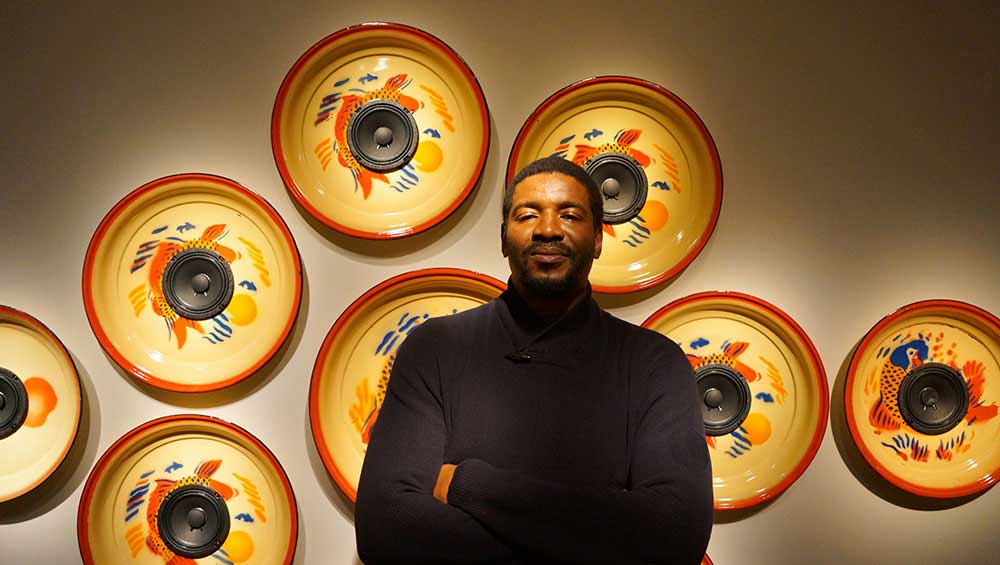
Emeka Ogboh portrait, copyright the artist.
by DAVID TRIGG
The power of sound to transport us to places where we are not physically present has long fascinated Emeka Ogboh (b1977, Enugu, Nigeria). The Berlin-based Nigerian artist has worked in a variety of mediums, but he is best known for his sonic installations inspired by his part-time home of Lagos, Nigeria’s most populous city, where silence is virtually an alien concept. Its urban soundtrack of chugging traffic, blaring music, yelling street traders and the ever-present chatter of its 14.8 million residents provides the raw material for many of Ogboh’s evocative artworks, which carry listeners to the beating heart of this sprawling metropolis.
The rich library of sounds that forms Ogboh’s Lagos Soundscapes (2008-) has reached listeners’ ears through headphones in gallery installations and intimate listening booths, as well as through loudspeakers on the streets of European cities. These aural portraits of the city also provide the foundation for his haunting debut album, Beyond the Yellow Haze, released at the beginning of this year. Recently, however, his focus has shifted towards working with singers on musical projects, exploring themes of migration, exile and his Igbo heritage. Speaking to Studio International on the eve of his exhibition Ámà: The Gathering Place, at the Gropius Bau in Berlin, he explains his differing approaches to sound, from field recordings and electronic music production to directing vocalists.
Originally trained as a graphic designer, Ogboh was never comfortable with painting and sculpture, finding them too static. He was first introduced to the potential of sound in 2008, when he attended a workshop at Fayoum Art Center in Tunis, Egypt, led by the Austrian multimedia artist Harald Scherz. The experience had a profound effect on him, sparking his interest in sound’s ability to fracture location and time. “Coming back to Lagos, I became more attuned to the sounds around me,” he says, “and after an encounter where I was able to identify the sounds of the city during a phone conversation with an out-of-towner, I thought it would be interesting to document Lagos through sound.” The notion of being able to recognise a city solely by its sounds captivated Ogboh. Armed with a field recorder, he began exploring the urban environment on foot, by car and by bus, capturing its multifaceted sonics. “This opened a new world for me,” he says. “I would discover more about the city through the sounds it generated and through the stories embedded in the recordings – stories of a city and its people.”
Ogboh’s recordings reveal a city brimming with diversity. “It is a melting pot of the many different cultural groups across Nigeria and some parts of west Africa,” he says. “You can catch this diversity in the languages and music picked up on the recordings. These anthropological revelations are some of the things that excite me most about urban soundscapes.” For Ogboh, the city is not simply a producer of noise, it is a composer of sound and rhythm. With no logical progression or clear narrative, the listening experience can be exciting and unsettling: doors slam, engines purr and a range of voices cut across each other in bustling marketplaces as honking vehicles zoom by. “I want listeners to be transported to Lagos,” says Ogboh. “I want them to feel what it is like to be in those spaces.”

Danfo buses in Lagos. Photo: Emeka Ogboh.
A prominent reference in Ogboh’s works is the iconic yellow danfo bus, a common sight in Lagos, which is heard in many of his recordings. These ubiquitous, eight-to-10-seater minbuses are hugely popular, functioning as social spaces as much as modes of transport. “The danfo embodies the spirit and soul of Lagos as it ferries its populace through the city’s network of roads,” says Ogboh. For him, riding in a small danfo provides a space to experience the breadth of the city’s sonic landscape, from conversations and arguments to the sounds of the vehicle itself and its conductor calling out destinations. Sometimes it serves as a studio, a space of inspiration in which to make his recordings. For the 2012 exhibition The Progress of Love, at the Menil Collection in Houston, Ogboh installed a danfo in the gallery. Visitors were invited to enter the vehicle and listen to his soundscapes, a strategy that shifted the experience of his work from a purely sonic encounter to a physical interaction. He repeated this in 2014 at the Africa Center in Harlem and again in 2019 at the Palais de Tokyo in Paris for the group exhibition City Prince/sses.

Emeka Ogboh, LOS-CDG, 2019. Multichannel sound installation and Danfo bus. Installation view, City Prince/sses, Palais de Tokyo. Copyright Palais de Tokyo. Photo: Marc Domage.
In 2014, Ogboh arrived in Berlin for a year-long DAAD artist residency and has remained a resident of the city ever since. Compared with Lagos, he found the German capital to be an oasis of calm. In fact, it was so quiet that he found it hard to sleep. The move to Berlin also saw him exploring new ways of using sound. “There was really nothing of interest to record in Berlin, or at least I felt that way,” he says. “So, I started exploring the possibilities of working with archival sounds, choirs and composers to create sound installations. This period also pushed me to go through my hard drives and review the various field recordings I had made of Lagos. And while doing this, I started toying with finding new ways to open people’s ears to the city. This I did through electronic music, and I have Berlin to thank for it.”
Ogboh’s 11.5-minute track Danfo Mello, from Beyond the Yellow Haze, is a hypnotising piece of music, featuring the diverse sounds of Lagos woven together with subtle layers of ambient electronics and rhythmic loops. Usually, Ogboh’s field recordings are presented with minimal manipulation, with the emphasis being on recontextualising the sounds. However, in his first foray into electronic music production, he started experimenting with sound, cutting up and layering his recordings and adding subtle effects, beats and other musical elements. “I always wanted to make a solo album,” he says. “I knew I could compose or make music, but I didn’t know how to use a digital audio workstation to achieve this. So, I took some classes and dedicated some time to learning how to use the tools.” As with many of his installations, the field recordings provide the starting point for Ogboh’s compositions. “I begin the process by going through my archives and selecting certain excerpts. I then listen to these on loop over a long period of time. They inform the choice of the composition I create and the samples I use. The music builds up slowly.”
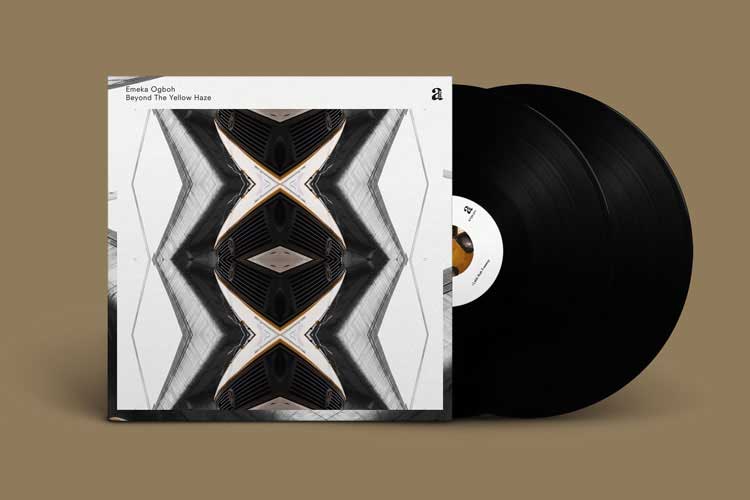
Emeka Ogboh, Beyond The Yellow Haze album cover. Copyright the artist and A-TON, 2021.
Beyond the Yellow Haze was released on A-TON, a sub-project of Berlin’s Ostgut Ton, the inhouse label of the legendary Berghain nightclub. During the pandemic, the club’s cavernous dance floor became an art gallery, hosting the 117-artist show Studio Berlin. It was here that Ogboh presented Ayilara (2020), a piece inspired by Lagos’s notorious red-light district. Playing out over the club’s world-famous Funktion-One sound system, it caught the ears of Ostgut Ton’s staff, who invited Ogboh to release his debut LP with them. Although the album has just five tracks, it conveys a range of moods and atmospheres, from the sinister piano chords and traffic noise of the opening track, Lekki Aiah Freeway, to the driving rhythms and street market banter of Everydaywehustlin, to the dreamy sonics of Palm Groove, with its distant chanting, melancholic synths and pattering rain. A follow-up is in the pipeline, slated for a 2022 release. “It’s titled 6°30′33.372″N 3°22′0.66″E”, Ogboh says, “which happens to be the GPS coordinates of a location in Lagos.”
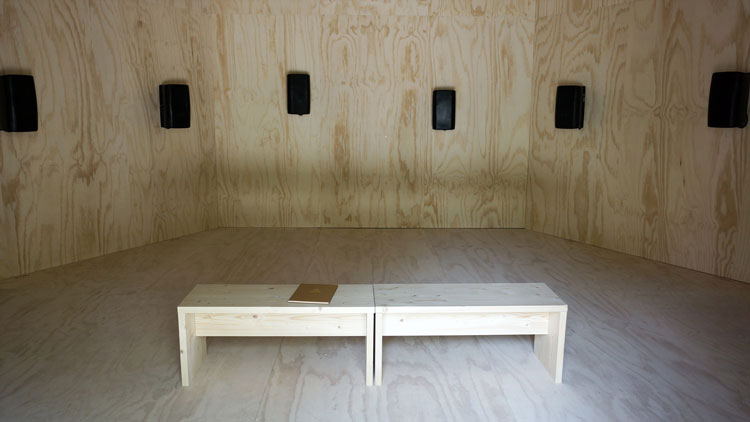
Emeka Ogboh, The Song of the Germans. Multichannel sound installation and book. Installation view, Venice Biennale 2015. Copyright The Artist.
Since his arrival in Europe, migration and exile have become important themes in Ogboh’s installations. For the 2015 Venice Biennale, he created The Song of the Germans, a 10-channel audio work for which he recorded the German national anthem in 10 different African languages: Igbo, Yoruba, Bamoun, More, Twi, Ewondo, Sango, Douala, Kikongo and Lingala. The singers – all African expatriates living in Germany – are heard individually on separate speakers, but all sing together in varying combinations. “The work was installed in one of the 18th-century towers at the Arsenale,” says Ogboh. “This location lent a special acoustic to the music. The piece was produced during the European refugee crisis; in Germany, questions around race, identity and belonging practically took over the news.”
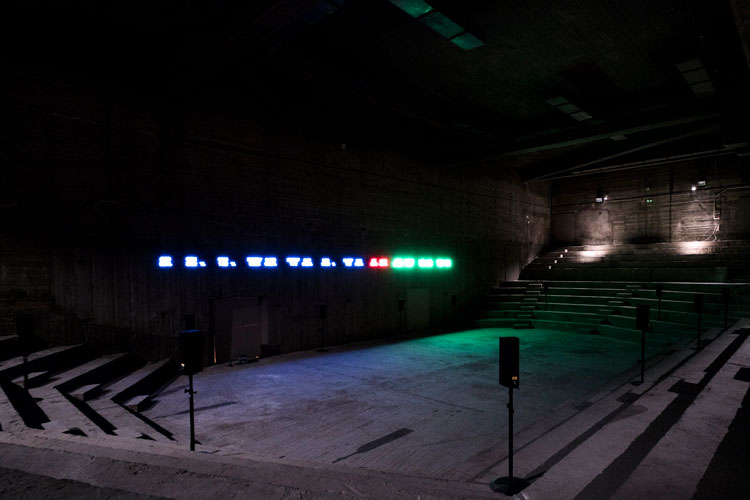
Emeka Ogboh, The Way Earthly Things Are Going, 2017. Multichannel sound installation and LED display. Installation view, Documenta 14, Athens, 2017. Photo: Mathias Völzke.
Two years later, Ogboh was invited to participate in Documenta 14, held that year in Athens, Greece, as well as its traditional home of Kassel, Germany. He presented The Way Earthly Things Are Going (2017), which was later shown in the Tanks at Tate Modern.
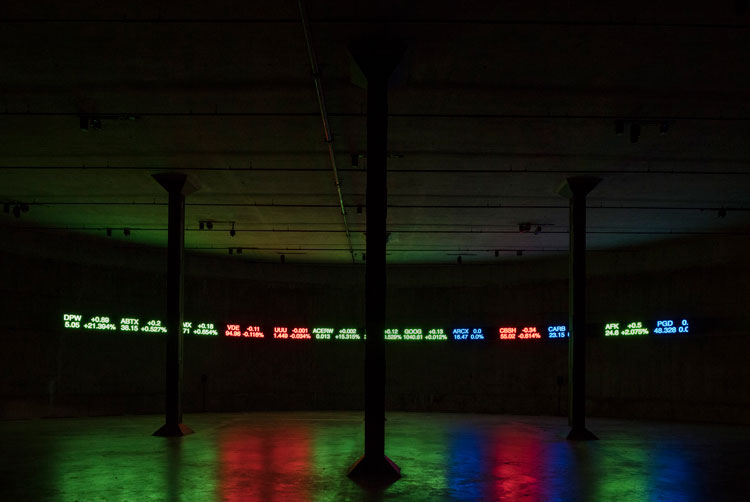
Emeka Ogboh, The Way Earthly Things Are Going, 2017. Multichannel sound installation and LED display. Installation view, The Tanks, Tate Modern. Copyright Tate Modern.
The mesmerising installation comprises live stock-exchange data presented on scrolling LED displays and accompanied by When I forget, I’m glad, an ancient Greek lament recorded specifically for the piece and sung by Pleiades, an all-female vocal group. “The work was inspired by the Greek financial crisis of 2007-08, which had an impact that resonated across the world,” he says. “That’s where the idea of working with real-time stock data came from. These numbers define how the world’s economy is performing by pulling live feeds from different stock exchanges around the world. And the lamentation song, When I forget, I’m glad, which references exile, provided the perfect soundtrack for the installation. Economic migration was one of the main consequences of the financial crisis, and this was the situation a lot of Greeks found themselves in during this period.”
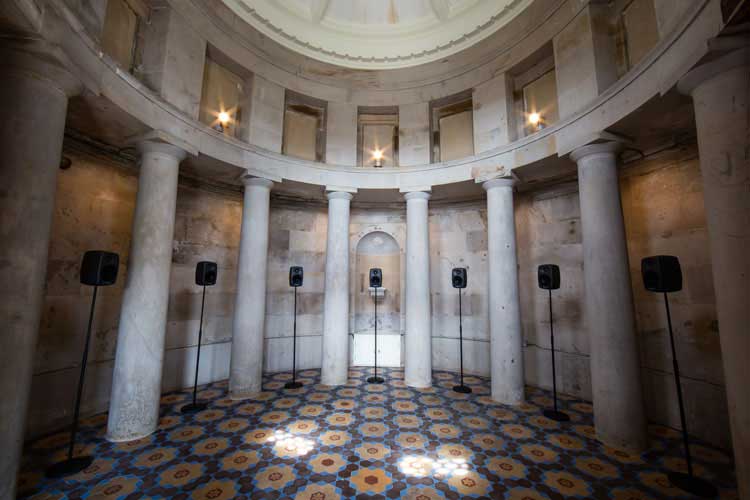
Emeka Ogboh, The Song of the Union. Multichannel sound installation. Installation view, Edinburgh Art Festival 2021. Photo: Sally Jubb, copyright Talbot Rice Gallery.
For the 2021 edition of the Edinburgh Art Festival, Ogboh turned his attention to Brexit, in Song of the Union (2021), which he installed at the city’s monument to Robert Burns. Featuring Scottish-based singers from all 27 EU member states performing Auld Lang Syne in their mother tongues (as well as one from the recently departed UK), the piece references the moment in January 2020 when members of the European parliament took to their feet, held hands, and sang Burns’ best-known song following their approval of the terms of the UK’s withdrawal from the EU. “The idea to create this work came while I was visiting Edinburgh shortly after the European parliament’s Brexit vote on 29 January,” Ogboh says. “The connection to Scotland was made during my site visit to the Burns Monument, and a seed was planted to extend what happened at the end of that EU parliament session into the public realm, and into different languages.” Although living in Scotland, many of the participating singers were unable to vote in the UK’s 2016 EU membership referendum; Ogboh’s choir gives voice to the unrepresented while demonstrating the universal power of music to transcend borders and bring people together. “The 28 individually recorded voices are synchronised and relayed across seven audio channels,” he explains. “An algorithm randomly selects the voices in four cycles. They perform like a choir, with one starting and six more coming in one after the other before the end of the song. No voice is repeated until all the other voices have been heard within the four cycles.”
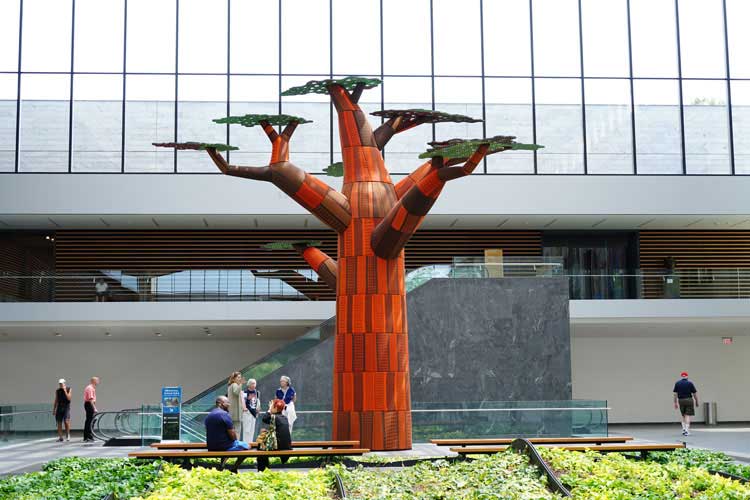
Emeka Ogboh, Ámà: the gathering place, 2019. Multimedia installation (sound, sculpture, and fabrics). Installation view, the Ames family Atrium, Cleveland Museum of Art. Copyright the artist.
In his ambitious installation Ámà: The Gathering Place (2019/2021), which can currently be experienced in the vast atrium of Berlin’s Gropius Bau, Ogboh explores his Igbo heritage. Originally commissioned for the Ames Family Atrium at the Cleveland Museum of Art, it comprises a nine-metre-tall sculptural tree and a 12-channel sound installation featuring traditional Igbo folk songs from Nigeria. “I am an Igbo man,” says Ogboh, “and I am very interested in drawing inspiration from my culture and propagating it through my art practice.” “Ámà” is an Igbo word meaning “village square”, though the concept is much broader than a place where people gather. The Ámà is a mutable space, often centred around a large tree, that is used for local government, markets, rituals and all manner of social activities. In a region with a strong oral tradition, it is also a place for listening: a site where young people are instructed, where values are instilled and where history and culture is transmitted. Folk music plays a huge part in this oral culture, and for traditional Igbo communities singing is a fundamental educational tool.
In likening the atrium at Gropius Bau to an Igbo village square, Ogboh compares and contrasts the social role that the two spaces play. “Both sites are contact zones, spaces of gathering and of ritual activities, in their respective settings,” he says. The installation not only evokes Igbo culture through its choral soundtrack but also through the inclusion of Akwétè fabric combining traditional and contemporary motifs. This boldly coloured material with its striking patterns is used for the bark on Ogboh’s towering tree and the beanbags that litter the floor, inviting visitors to recline, listen and be transported by the music. “I grew up hearing a lot of these songs and thought they were the original compositions, but actually they have changed over time,” says Ogboh. “The lyrics remain constant but the way it is sung changes.” Similarly, in Ogboh’s practice, sound remains a constant presence, but the way it is experienced has evolved. The solitary headphone experience has given way to social encounters. Sound certainly has the ability to whisk us away to far-off places, but, as Ogboh teaches us, it can also bring us together in the here and now.
• Emeka Ogboh’s Ámà: The Gathering Place can be experienced in Gropius Bau’s Atrium, Berlin, until 16 January 2022